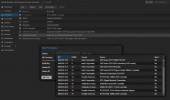Hello, I'm having an issue getting proxmox GPU passthrough to work with a newer re-installation that was working prior.
ThinkCentre M83 Tower
Lenovo SDK0E50510 WIN (SHARKBAY) Motherboard
UEFI Only
Intel i7-4790 CPU
250 GB Samsung SSD + 256 GB Seagate SSD (ZFS RAID1 - 250 GB)
I previously had proxmox 7 (I believe) and was using LVM for VM storage. I was able to get GPU passthrough working on the same machine using grub. My instructions below.
cp /etc/default/grub /root/grub-bkup
nano /etc/default/grub
GRUB_CMDLINE_LINUX_DEFAULT="quiet intel_iommu=on i915.enable_gvt=1"
update-grub
reboot
dmesg | grep -e DMAR -e IOMMU
cp /etc/modules /root/modules-bkup
nano /etc/modules
# Modules required for PCI passthrough
vfio
vfio_iommu_type1
vfio_pci
vfio_virqfd
# Modules required for Intel GVT
kvmgt
exngt
vfio-mdev
reboot
lspci -nnv | grep VGA
00:02.0 VGA compatible controller [0300]: Intel Corporation Xeon E3-1200 v3/4th Gen Core Processor Integrated Graphics Controller [8086:0412] (rev 06) (prog-if 00 [VGA controller])
*The PCI address of the iGPU is 00:02.0
I'm now trying to get it working with my newer install that was done using zfs, and as I understand it EFI for booting.
root@proxmox:~# efibootmgr -v
BootCurrent: 000E
Timeout: 1 seconds
BootOrder: 0000,000E,001E,001B,001D,0004,0005
Boot0000* Linux Boot Manager HD(2,GPT,4cb46da8-60b0-42e0-8c0a-cb78ae72d033,0x800,0x100000)/File(\EFI\SYSTEMD\SYSTEMD-BOOTX64.EFI)
Boot0004* Generic Usb Device VenHw(99e275e7-75a0-4b37-a2e6-c5385e6c00cb)
Boot0005* CD/DVD Device VenHw(99e275e7-75a0-4b37-a2e6-c5385e6c00cb)
Boot000E* Samsung SSD 840 Series BBS(HD,,0x0)..BO
Boot001B* UEFI OS HD(2,GPT,4cb46da8-60b0-42e0-8c0a-cb78ae72d033,0x800,0x100000)/File(\EFI\BOOT\BOOTX64.EFI)
Boot001D* UEFI OS HD(2,GPT,e09c9466-1cea-41fd-ae7f-72ef59a980e3,0x800,0x100000)/File(\EFI\BOOT\BOOTX64.EFI)
Boot001E* Seagate SSD BBS(HD,,0x0)..BO
I'm tried the following instructions but Proxox GUI still show IOMMU is not enabled
cp /etc/kernel/cmdline /etc/kernel/cmdline-bkup
nano /etc/kernel/cmdline
quiet intel_iommu=on
iommu=pt
enable_gvt=1
proxmox-boot-tool refresh
dmesg | grep -e DMAR -e IOMMU
cp /etc/modules /root/modules-bkup
nano /etc/modules
# Modules required for PCI passthrough
vfio
vfio_iommu_type1
vfio_pci
vfio_virqfd
# Modules required for Intel GVT
kvmgt
exngt
vfio-mdev
reboot
Thanks for any help
ThinkCentre M83 Tower
Lenovo SDK0E50510 WIN (SHARKBAY) Motherboard
UEFI Only
Intel i7-4790 CPU
250 GB Samsung SSD + 256 GB Seagate SSD (ZFS RAID1 - 250 GB)
I previously had proxmox 7 (I believe) and was using LVM for VM storage. I was able to get GPU passthrough working on the same machine using grub. My instructions below.
cp /etc/default/grub /root/grub-bkup
nano /etc/default/grub
GRUB_CMDLINE_LINUX_DEFAULT="quiet intel_iommu=on i915.enable_gvt=1"
update-grub
reboot
dmesg | grep -e DMAR -e IOMMU
cp /etc/modules /root/modules-bkup
nano /etc/modules
# Modules required for PCI passthrough
vfio
vfio_iommu_type1
vfio_pci
vfio_virqfd
# Modules required for Intel GVT
kvmgt
exngt
vfio-mdev
reboot
lspci -nnv | grep VGA
00:02.0 VGA compatible controller [0300]: Intel Corporation Xeon E3-1200 v3/4th Gen Core Processor Integrated Graphics Controller [8086:0412] (rev 06) (prog-if 00 [VGA controller])
*The PCI address of the iGPU is 00:02.0
I'm now trying to get it working with my newer install that was done using zfs, and as I understand it EFI for booting.
root@proxmox:~# efibootmgr -v
BootCurrent: 000E
Timeout: 1 seconds
BootOrder: 0000,000E,001E,001B,001D,0004,0005
Boot0000* Linux Boot Manager HD(2,GPT,4cb46da8-60b0-42e0-8c0a-cb78ae72d033,0x800,0x100000)/File(\EFI\SYSTEMD\SYSTEMD-BOOTX64.EFI)
Boot0004* Generic Usb Device VenHw(99e275e7-75a0-4b37-a2e6-c5385e6c00cb)
Boot0005* CD/DVD Device VenHw(99e275e7-75a0-4b37-a2e6-c5385e6c00cb)
Boot000E* Samsung SSD 840 Series BBS(HD,,0x0)..BO
Boot001B* UEFI OS HD(2,GPT,4cb46da8-60b0-42e0-8c0a-cb78ae72d033,0x800,0x100000)/File(\EFI\BOOT\BOOTX64.EFI)
Boot001D* UEFI OS HD(2,GPT,e09c9466-1cea-41fd-ae7f-72ef59a980e3,0x800,0x100000)/File(\EFI\BOOT\BOOTX64.EFI)
Boot001E* Seagate SSD BBS(HD,,0x0)..BO
I'm tried the following instructions but Proxox GUI still show IOMMU is not enabled
cp /etc/kernel/cmdline /etc/kernel/cmdline-bkup
nano /etc/kernel/cmdline
quiet intel_iommu=on
iommu=pt
enable_gvt=1
proxmox-boot-tool refresh
dmesg | grep -e DMAR -e IOMMU
cp /etc/modules /root/modules-bkup
nano /etc/modules
# Modules required for PCI passthrough
vfio
vfio_iommu_type1
vfio_pci
vfio_virqfd
# Modules required for Intel GVT
kvmgt
exngt
vfio-mdev
reboot
Thanks for any help


